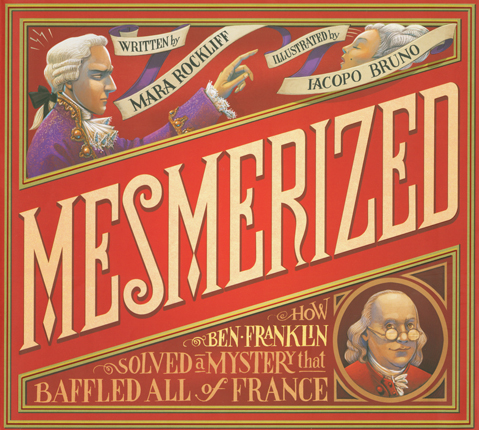Full Text Reviews: Booklist - 12/01/2014 *Starred Review* On brilliantly illustrated pages full of rococo details and beautifully calligraphed text, Rockliff tells the story of how Benjamin Franklin debunked Dr. Mesmer’s magical cure-all. As scientific innovation swept France in the eighteenth century, Mesmer decided to bring his own discovery to the mix—animal magnetism, an invisible force responsible for remarkable, seemingly spontaneous healing. Dubious of the true benefits of being mesmerized, King Louis XVI called on the most popular man of science, Ben Franklin, to help investigate. With a heavy emphasis on his use of the scientific method, Rockliff shows how Franklin’s experiment—blindfolding subjects so that they don’t know they’re being mesmerized—led to the discovery of the placebo effect, a vital component of medical testing to this day. Her dramatic text is perfectly complemented by Bruno’s lush, full-color illustrations, stuffed with period detail and sweeping ribbons and curlicues. Each page is teeming with personality, from the font choice to the layout to the expressive figures to the decorative details surrounding a name—on one spread, Franklin is in a tidy serif, while Mesmer is nearly choked by flourishes. Together, Rockliff and Bruno make the scientific method seem exciting, and kids interested in science and history will likely be, well, mesmerized. - Copyright 2014 Booklist. School Library Journal - 01/01/2015 Gr 2–5—Benjamin Franklin could be described in so many different ways: inventor, printer, scientist, thinker, diplomat. From this book, the word skeptic should be added to this list. While in France raising funds for the American rebellion against the British, Franklin was enlisted by Louis XVI to investigate the claims made by a young Austrian doctor who had much of Europe enthralled with his ability to remedy a wide variety of illnesses simply by waving an iron wand around their person. Calling it "animal magnetism," Franz Mesmer was treating the European elite by bringing them into darkened rooms while spellbinding music played on a glass armonica, invented by none other than Franklin himself. Mesmer would charge a rather large sum of money and pronounce his clients "cured." Doubtful of Mesmer's abilities, Franklin set about disproving the doctor's claims. Rockliff's lighthearted tone and lively writing style are enhanced by the use of different typefaces and print sizes, as well as a layout that will keep readers engaged throughout. Rockliff plays with words and rhythm, making this book an excellent choice for reading aloud. The artwork is infused with humor, and the individual's expressions throughout are a delight, from the look on the face of a swooning patient to Mesmer's own intense glare. There is much here to draw the eye and prod discussion. A lengthy author's note fills in the details of the story and provides information on the scientific method. Overall, a wonderful and fun-filled title that introduces yet another facet of a fascinating man.—Jody Kopple, Shady Hill School, Cambridge, MA - Copyright 2015 Publishers Weekly, Library Journal and/or School Library Journal used with permission. Bulletin for the Center... - 03/01/2015 When Louis XVI began to suspect that France’s newest rage-Dr. Franz Anton Mesmer with his unseen healing force that “streamed from the stars and flowed into his wand”-wasn’t quite on the level, he appointed the ever-popular Benjamin Franklin, currently in Parisian residence to curry French support for the newborn United States, to a committee to investigate Mesmer’s claims. Rockliff retells the episode with equal measures of gentle satire of aristocratic gullibility and tidy reconstruction of the scientific method used to unmask the humbug. Of particular note is her explanation of how the blinded tests Franklin devised to eliminate possible explanations are used by scientists today. She is also generous to the disgraced Mesmer (whose technique, now commonly called hypnotism, had more to do with autosuggestion than astral forces), crediting him with being on the right track concerning the mind’s role in healing, and in pointing the way toward the placebo effect. Although the four-page endnote definitely expands information about the two competing “scientists” and their showdown (Mesmer was represented by his proxy, Charles D’Eslon), the main text itself is sufficient for a cogent introduction. Digitally colored pencil illustrations underscore the humor, and boxed insets on the scientific method alert readers to pay attention to how Franklin went about his proof. A list of sources is included, and the discombobulating optical trickery of the endpaper design is worth its own visit. EB - Copyright 2015 The Board of Trustees of the University of Illinois. Loading...
|



